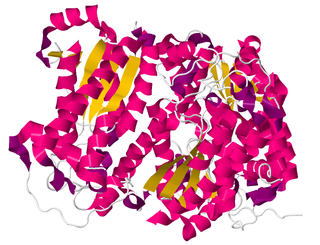Phosphagens, also known as macroergic compounds, are high energy storage compounds, also known as high-energy phosphate compounds, chiefly found in muscular tissue in animals. They allow a high-energy phosphate pool to be maintained in a concentration range, which, if it all were adenosine triphosphate (ATP), would create problems due to the ATP-consuming reactions in these tissues. As muscle tissues can have sudden demands for much energy, these compounds can maintain a reserve of high-energy phosphates that can be used as needed, to provide the energy that could not be immediately supplied by glycolysis or oxidative phosphorylation. Phosphagens supply immediate but limited energy.

Phosphocreatine, also known as creatine phosphate (CP) or PCr (Pcr), is a phosphorylated form of creatine that serves as a rapidly mobilizable reserve of high-energy phosphates in skeletal muscle, myocardium and the brain to recycle adenosine triphosphate, the energy currency of the cell.

In biochemistry, a phosphatase is an enzyme that uses water to cleave a phosphoric acid monoester into a phosphate ion and an alcohol. Because a phosphatase enzyme catalyzes the hydrolysis of its substrate, it is a subcategory of hydrolases. Phosphatase enzymes are essential to many biological functions, because phosphorylation and dephosphorylation serve diverse roles in cellular regulation and signaling. Whereas phosphatases remove phosphate groups from molecules, kinases catalyze the transfer of phosphate groups to molecules from ATP. Together, kinases and phosphatases direct a form of post-translational modification that is essential to the cell's regulatory network.
Hydrolase is a class of enzymes that commonly perform as biochemical catalysts that use water to break a chemical bond, which typically results in dividing a larger molecule into smaller molecules. Some common examples of hydrolase enzymes are esterases including lipases, phosphatases, glycosidases, peptidases, and nucleosidases.

In enzymology, a phosphonoacetate hydrolase (EC 3.11.1.2) is an enzyme that catalyzes the chemical reaction

In enzymology, an acylphosphatase (EC 3.6.1.7) is an enzyme that catalyzes the hydrolysis of the carboxyl-phosphate bond of acylphosphates, with acylphosphate and H2O as the two substrates of this enzyme, and carboxylate and phosphate as its two products:
In enzymology, a guanosine-5'-triphosphate,3'-diphosphate diphosphatase (EC 3.6.1.40) is an enzyme that catalyzes the chemical reaction

In enzymology, a nucleoside-diphosphatase (EC 3.6.1.6) is an enzyme that catalyzes the chemical reaction
In enzymology, a nucleoside-triphosphatase(NTPase) (EC 3.6.1.15) is an enzyme that catalyzes the chemical reaction
In enzymology, an undecaprenyl-diphosphatase (EC 3.6.1.27) is an enzyme that catalyzes the chemical reaction

In enzymology, a bisphosphoglycerate phosphatase (EC 3.1.3.13) is an enzyme that catalyzes the chemical reaction
The enzyme dolichyl-phosphatase (EC 3.1.3.51) catalyzes the reaction
The enzyme glycerol-1-phosphatase (EC 3.1.3.21) catalyzes the reaction
The enzyme lipid-phosphate phosphatase (EC 3.1.3.76) catalyzes the reaction

The enzyme phosphatidate phosphatase (PAP, EC 3.1.3.4) is a key regulatory enzyme in lipid metabolism, catalyzing the conversion of phosphatidate to diacylglycerol:
The enzyme streptomycin-6-phosphatase (EC 3.1.3.39) catalyzes the reaction

In enzymology, a glucosylceramidase (EC 3.2.1.45) is an enzyme that catalyzes the chemical reaction

In enzymology, a ADP-ribosyl cyclase/cyclic ADP-ribose hydrolase (EC 3.2.2.6) is a bifunctional enzyme that catalyzes the chemical reaction

In enzymology, a creatininase (EC 3.5.2.10) is an enzyme that catalyses the hydrolysis of creatinine to creatine, which can then be metabolised to urea and sarcosine by creatinase.

In molecular biology, the ATP:guanido phosphotransferase family is a family of structurally and functionally related enzymes, that reversibly catalyse the transfer of phosphate between ATP and various phosphagens. The enzymes belonging to this family include:











